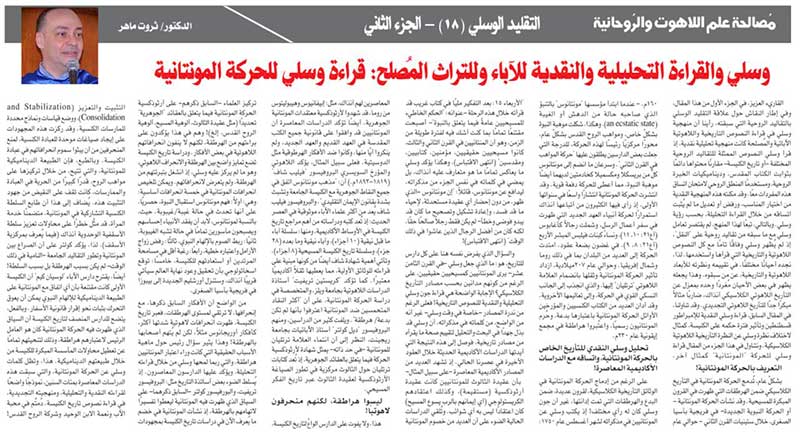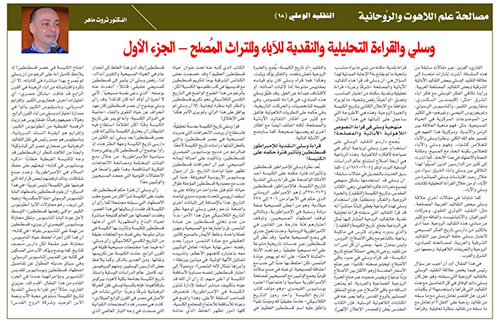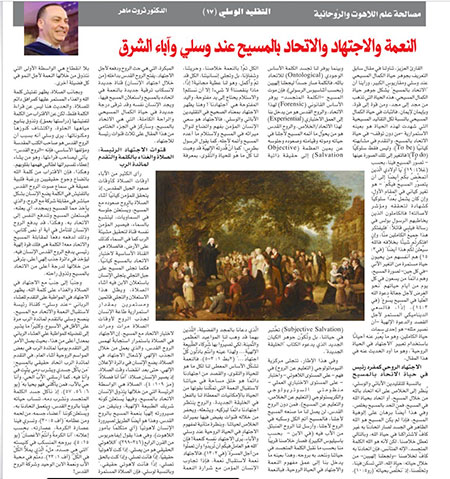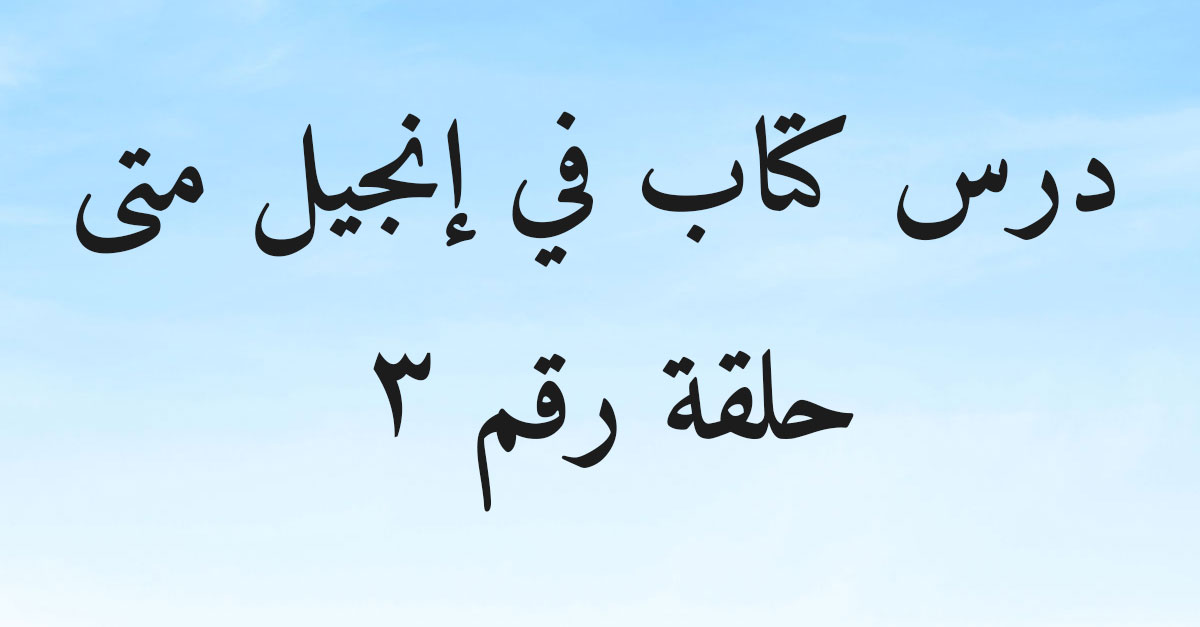الديداخي - The Didache
By: Dr. Tharwat Maher Nagib,
PhD Theological Studies, Regent University, VA
Arabic Translation by: Nevin Fadel
By: Dr. Tharwat Maher Nagib,
PhD Theological Studies, Regent University, VA
Arabic Translation by: Nevin Fadel
Introduction: Context of the Didache
The Didache, or The Teaching of the (Twelve) Apostles, is considered one of the earliest and most important texts that help with understanding Christianity during the first and early second century. The content of the text reflects an early state of the church life, which might be traced back to the second half of the first century. The simplicity of prayers, the instructions on liturgy, and the continued existence of itinerant ministers confirm the possibility of this early state [1]. On the other hand, many scholars assert that the whole text has been edited into its final form during the first half of the second century. The document most probably reached its final form by a date in between AD 80 and AD 120 or maximum AD 150 [2]. Egypt, Syria, and Palestine are considered possible places where the Didache originated, but it was most likely in Syria [3].
مقدمة: سياق الديداخي
يعتبر الديداخي، أو تعاليم الرسل (الاثني عشر)، من أقدم وأهم النصوص التي ساعدت في فهم المسيحية خلال القرن الأول وأوائل القرن الثاني. يعكس محتوى النص حالة مبكرة من حياة الكنيسة، والتي يمكن إرجاعها إلى النصف الثاني من القرن الأول. إن بساطة الصلاة، والتعليم حول الليتورجيا، واستمرار وجود الخدام المتجولين، تؤكد إمكانية هذه الحالة المبكرة. من ناحية أخرى، يؤكد العديد من العلماء أن النص بأكمله قد تم تحريره في شكله النهائي خلال النصف الأول من القرن الثاني. من المحتمل أن تكون الوثيقة قد وصلت إلى شكلها النهائي بتاريخ ما بين ۸۰ و ۱۲۰ م أو ۱۵۰ م كحد أقصي. تعتبر مصر وسوريا وفلسطين من الأماكن المحتملة التي نشأت فيها الديداخية، لكنها كانت على الأرجح في سوريا.
Archbishop Philotheos Bryennios discovered the first copy of the Didache in 1873 in the Holy Sepulcher Church of Constantinople [4]. This version of the Didache was not in a separate manuscript. It was found in the Codex Hierosolymitanus, which contained some other important ancient texts such as the Epistle of Barnabas, the full Greek text of the first and second Clement, and thirteen letters of Ignatius [5]. The famous German Lutheran historian Adolf von Harnack published one of the most well-known early translations of the Didache, with a commentary on the text, in 1884. This German translation helped spread the text among the Western scholars [6].
اكتشف رئيس الأساقفة فيلوثيوس برينيوس النسخة الأولى من الديداخي في عام ۱۸۷۳ في كنيسة القيامة في القسطنطينية. لم يكن هذا الإصدار من الديداخي في مخطوطة منفصلة. تم العثور عليها في مخطوطة هيروسوليميتانوس ، التي تحتوي على بعض النصوص القديمة الهامة الأخرى مثل رسالة بولس الرسول لبرنابا ، والنص اليوناني الكامل لكليمان الأول والثاني ، وثلاثة عشر حرفًا لإغناطيوس. نشر المؤرخ الألماني اللوثري الشهير أدولف فون هارناك واحدة من أشهر الترجمات المبكرة للديداخي، مع تعليق على النص، في عام ١٨٨٤. ساعدت هذه الترجمة الألمانية على نشر النص بين العلماء الغربيين.
Composition of the Didache
Scholars divide the Didache into 16 distinct chapters, and divide these chapters into three sections. These three sections are: the Two Ways teaching (chapters 1-6), instructions on liturgy and church order (chapters 7-15), and an eschatological section (chapter 16).
However, to emphasize the importance of liturgy, some scholars, especially Coptic scholars, divide the second section (chapters 7-15) into two separate sections: liturgical (chapters 7-10) and church order (chapters 11-15).
تكوين الديداخي
يقسم العلماء الديداخي إلى ١٦ اصحاحًا مميزًا، ويقسمون هذه الفصول إلى ثلاثة أقسام. هذه الأقسام الثلاثة هي: تعليم الطريقين (الفصول ١ – ٦ )، تعليم حول الليتورجيا والنظام الكنسي الفصول ( ٧-١٥) وقسم الأخرويات الفصل (١٦). ومع ذلك، للتأكيد على أهمية الليتورجيا، قام بعض العلماء، وخاصة العلماء الأقباط، بتقسيم القسم الثاني الفصول (٧ – ١٥) إلى قسمين منفصلين الليتورجيا (الفصول ٧- ۱۰) والنظام الكنسي (الفصول ١١-١٥)
The Didache in general represents a portrait of an early Jewish-Christian community. Jewish traditions and Christian beliefs were fused together to form the characteristics of this community. This “Jewish-Christian” fusion can be noticed in many aspects of this early Christian life. The Didache implicitly sheds light on this situation through its texts which deal with the different Christian ethics and practices.
يمثل الديداخي بشكل عام صورة لمجتمع يهودي مسيحي مبكر. تم دمج التقاليد اليهودية والمعتقدات المسيحية معا لتشكيل خصائص هذا المجتمع. يمكن ملاحظة هذا الاندماج “اليهودي المسيحي” في العديد من جوانب هذه الحياة المسيحية المبكرة. يلقي الديداخي الضوء ضمنيًا على هذا الوضع من خلال نصوصه التي تتناول الأخلاق والممارسات المسيحية المختلفة.
Purpose of the Didache Many scholars agree that the Didache is a composite text which has been developed into its final form by an editor, who is commonly known as the Didachist. The Didachist combined earlier sources, written and oral, to create a document for a specific purpose. It is widely accepted to assume that the final form of the Didache was intended to be used as a form of catechesis or a manual of Christian instruction. The analytical reading of the Didache asserts that in addition to the didactic purpose of the Didache, the Didachist aimed to present a text to his community that helps to standardize its Christian practices [7], in a way that accommodates the Jewish components into the Christian belief. In other words, the Didache can be considered a step towards institutionalization of the church in a way that expresses its Jewish-Christian identity. This purpose clearly appears through the different sections of the Didache as follows.
الغرض من الديداخي
يتفق العديد من العلماء على أن الديداخي هو نص مركب تم تطويره إلى شكله النهائي بواسطة محرر يُعرف عمومًا باسم الديداخية. قام كاتب الديداخي بدمج المصادر السابقة، المكتوبة والشفوية، لإنشاء مستند لغرض معين من المقبول على نطاق واسع الافتراض أن الشكل النهائي للديداخي كان مقصودا استخدامه كشكل من أشكال التعليم المسيحي أو دليل للتعليم المسيحي. تؤكد القراءة التحليلية للديداخي أنه بالإضافة إلى الغرض التعليمي للديداخي، كان الديداخي يهدف إلى تقديم نص إلى مجتمعه يساعد في توحيد ممارساته المسيحية، بطريقة تلائم المكونات اليهودية مع عقيدة المسيحيين. بعبارة أخرى، يمكن
اعتبار الديداخي خطوة نحو إضفاء الطابع المؤسسي على الكنيسة بطريقة تعبر عن هويتها اليهودية المسيحية. يظهر هذا الغرض بوضوح من خلال أقسام مختلفة من الديداخي على النحو التالي.
The Two Ways teaching (Did. 1-6)
The two ways in Did. 1-6 is an ethical teaching that depends on a widespread tradition. Certainly, this teaching, which explains the way of life and the way of death, is rooted in the Jewish tradition. It can be found in the texts of the Old Testament such as Jer 21: 8, Deu 30: 19, Ps 1, Ps 119: 29, 30, and in some apocryphal Jewish books such as Testament of Asher, 1 Enoch (91: 18-19, 94: 1-4), and The Book of Jubilees (7: 26). Also, the same teaching can be found in some other early Christian writings such as the Epistle of Barnabas, The Didascalia, The Apostolic Church Order, and the Life of Shenouta [8].
تعليم الطريقان (الفصول من ١ - ٦)
الطريقان في الفصول من ١ – ٦ هو تعليم أخلاقي يعتمد على تقليد واسع الانتشار ان هذا التعليم، الذي يشرح طريقة الحياة وطريقة الموت متجذر في التقليد اليهودي. يمكن ان نجده في نصوص العهد القديم مثل إرميا :۲۱ : ۸ ، تثنية ٣٠: ١٩ ، مزمور ۱ ، مز ۱۱۹: ۲۹ ، ۳۰ ، وفي بعض الكتب اليهودية المنحولة مثل عهد آشر ، ۱ أخنوخ ۹۱: ١٨ – ۱۹ ، ۹٤ : ١-٤) ، وكتاب اليوبيلات (٧: ٢٦). أيضا، يمكن العثور على نفس التعليم في بعض الكتابات المسيحية المبكرة الأخرى مثل رسالة بولس الرسول لبرنابا، وديداسكاليا ورهبانية الكنيسة الرسولية، وحياة شنودة.
Likely, Did. 1-6 was used to provide catechesis prior to baptism (Did. 7: 1), which means that whoever wants to be a part of this Christian community must read this text first. The idea of catechesis prior to joining the Christian community (Did. 7: 1) can be compared to the Jewish idea which emphasizes on the necessity of reading The Community Rule[9] prior to the admission of new members into the Jewish community. Also, using the parental tone in the phrase “my child” in (Did. 3: 1, 3, 4, 5, 6, and 4: 1) reminds the reader of the Jewish Wisdom Tradition, and it might suggest replacing the Christian teacher in place of the Jewish Rabbi.
ان الفصول من ١ – ٦ كانت تستخدم لتقديم التعليم المسيحي قبل المعمودية (۱:۷)، مما يعني أن كل من يريد أن يكون جزءًا من هذه الجماعة المسيحية يجب أن يقرأ هذا النص أولاً. يمكن مقارنة فكرة التعليم المسيحي قبل الانضمام إلى المجتمع المسيحي (۷ :۱) بالفكرة اليهودية التي تؤكد على ضرورة قراءة قاعدة المجتمع قبل قبول أعضاء جدد في المجتمع اليهودي. كما أن استخدام اللهجة الأبوية في عبارة “ابني” في (۳: ۱ و ۳ و ٤ و ٥ و ٦ و ٤: ١) يُذكّر القارئ بتقليد الحكمة اليهودي، ويمكن اقتراح استبدال كلمة المعلم المسيحي مكان الحاخام اليهودي.
By putting the two ways teaching as the first section of the Didache, the Didachist wanted to say that a new community exists here, and this new community has rules in order for people to be accepted in it. This is an example of what might be described as “rules for the community to standardize the required ethical concepts in this community”. In addition, the Didachist was careful to add a Christian section (Did. 1: 3-2: 1), most probably from the Gospel of Matthew or an oral tradition, to inlay this Jewish tradition (Did. 1-6), or to Christianize it in order to be a good reflection of the Jewish-Christian identity of his community.
من خلال وضع تعليم الطريقين في القسم الأول من الديداخي، أراد كاتب الديداخي أن يقول إن هناك مجتمعًا جديدًا موجوداً هنا ، وهذا المجتمع الجديد لديه قواعد من أجل قبول الناس فيه. هذا مثال لما يمكن وصفه بـ “قواعد للمجتمع لتوحيد المفاهيم الأخلاقية المطلوبة في هذا المجتمع”. بالإضافة إلى ذلك، كان الديداخي حريصا على إضافة قسم مسيحي (۱: ۳ – ۲ :۱) على الأرجح من إنجيل متى أو من التقليد الشفوي، لترسيخ هذا التقليد اليهودي (۱-٦) ، أو لجعلها مسيحية الهوية لتكون انعكاسا جيدًا للهوية اليهودية المسيحية لمجتمعه.
The Liturgical section (Did. 7-10)
This section is divided into three themes: Baptism (chapter 7), Fasts and Prayer (chapter 8), and the Eucharist (chapters 9-10). As mentioned before, the idea of catechesis prior to baptism per se (Did. 7: 1) can be compared to a similar Jewish idea. In addition, baptism in running water (Did. 7: 1) reminds the reader of the ritual washing in Judaism (tevilah). On the other hand, the Trinitarian formula of baptism (Did. 7: 1, 3) preserves its authenticity as a Christian practice.
القسم الليتورجي (٧ – ١٠)
ينقسم هذا القسم إلى ثلاثة مواضيع المعمودية الفصل (۷) الصوم والصلاة (الفصل (۸) ، والافخاريستيا الفصول ) ۹ – ۱۰). كما ذكرنا سابقاً، يمكن مقارنة فكرة التعليم المسيحي قبل المعمودية بحد ذاتها (۷: ۱) بفكرة يهودية مماثلة. بالإضافة إلى ذلك، فإن المعمودية في الماء الجاري (٧: ١) تذكر القارئ بطقوس الاغتسال في اليهودية (الطفيلة). من ناحية أخرى، فإن صيغة المعمودية بالثالوث (٧: ١، ٣) تحفظ أصالتها كممارسة مسيحية.
It is noticeable that the text of baptism does not focus on any theological understanding of the meaning of baptism per se. It does not focus on repentance, forgiveness of sins, or burial and resurrection with Christ. It only focuses on the baptismal instructions and rituals, such as the formula of baptism (Did. 7: 1), method of baptism (Did. 7: 2, 3), and the fast that precedes baptism (Did. 7: 4). This focus on baptismal instructions asserts that the Didachist wanted to set guidelines that standardize the practice of baptism per se rather than discussing any theological understanding behind it.
من الملاحظ أن نص المعمودية لا يركز على أي فهم لاهوتي لمعنى المعمودية في حد ذاته. إنه لا يركز على التوبة أو غفران الخطايا أو الدفن والقيامة مع المسيح. إنه يركز فقط على تعليمات وطقوس المعمودية، مثل نص المعمودية (۷: ۱) ، طريقة المعمودية (۷: ۲ ، ۳) ، والصوم الذي يسبق المعمودية (٧: ٤) . يؤكد هذا التركيز على تعليمات المعمودية أن الديداخي أراد وضع مبادئ توجيهية موحدة لممارسة المعمودية في حد ذاتها بدلاً من مناقشة أي فهم لاهوتي وراءها.
Concerning fasts and prayer (Did. 8), and according to the Didache, fasting one or two days before baptism is required from “the one baptizing and the one who is to be baptized” (Did. 7: 4). In general, fasting two days a week is required. The Didache replaces Wednesday and Friday instead of the Jewish Monday and Thursday fasts (Did. 8: 1). Concerning prayer, the Didache advises not to pray like the hypocrites, “instead, pray like this, just as the Lord commanded in his Gospel…” (Did. 8: 2). The Lord’s Prayer[10] should be repeated three times a day (Did. 8: 3), which identifies with the Jewish Tradition (Ps 55: 17, Dan 6: 10)[11]. In spite of these parallels with the Jewish tradition that exist in the instructions of fasts and prayer, this text (Did. 8) can be considered one of the most important in the Didache that distinguishes between Christian practices and Jewish traditions. In these instructions of fasts and prayer, it is obvious that the Didache tells us that a separate community exists, and this community has its own standards.
فيما يتعلق بالصوم والصلاة (قسم ۸) ، وبحسب الديداخي ، فإن الصوم قبل المعمودية بيوم أو يومين مطلوب من “المعمد والمعمد ( ٤ ) . بشكل عام، يجب صيام يومين في الأسبوع. يستبدل الديداخي الأربعاء والجمعة بدلاً من صيام الإثنين والخميس اليهودي (۸: ۱). فيما يتعلق بالصلاة، ينصح الديداخي بعدم الصلاة مثل المرائين، بل صلوا هكذا كما أمر الرب في إنجيله …” (۸: ۲). الصلاة الربانية يجب أن تتكرر ثلاث مرات في اليوم (٨: ٣) ، وهو ما يتوافق مع التقليد اليهودي (مز ١٧:٥٥ ، دانيال ٦: ١٠ ) على الرغم من هذه المقارنات مع التقليد اليهودي الموجود في تعليمات الصوم والصلاة، يمكن اعتبار هذا النص (۸) أحد أهم النصوص في الديداخية التي تميز بين الممارسات المسيحية والتقاليد اليهودية في تعليمات الصوم والصلاة هذه، من الواضح أن الديداخي يخبرنا بوجود مجتمع منفصل، وهذا المجتمع له معاييره الخاصة.
The Eucharist (Did. 9, 10) comes at the end of this liturgical section. The eucharistic prayer over the cup (Did. 9: 2) follows the Jewish meal prayer model (Toda/Todah)[12] by referring to “the holy vine of David”. Actually, the heart of this eucharistic text reflects a Davidic Christology[13] which illuminates the Jewish roots of Christianity. At the same time, it shows Jesus as the revealer of knowledge and the source of life (Did. 9: 2, 3). In this eucharistic text, the Didache presents a portrait of a Jewish-Christian community that celebrates God’s actions as made known through the revelatory work of Jesus[14], and there is no place in this celebration for any non-baptized person (Did. 9: 5). Moreover, it sheds light on this Jewish-Christian community as part of a wider community, which is the universal church (Did. 9: 4, 10: 5). At this point, it seems that the Didache wants to define this Jewish-Christian community, not only by placing guidelines that standardize its practices, but also by proclaiming its belonging to a wider universal church that believes in an eschatological destiny (Did. 10: 6), and this proclamation can add an additional weight to the whole text of the Didache.
تأتي الافخارستيا (۹ ، ۱۰) في نهاية هذا الجزء الليتورجي. صلاة الافخارستيا على الكأس (۹: ۲) تتبع نموذج صلاة الوجبة اليهودية ( (TodaToda كلمة العبرية تعني “تقديم الشكر”. بالإشارة إلى “كرمة داود المقدسة” . في الحقيقة ، يعكس قلب هذا النص الإفخارستي كريستولوجيا داود التي تضيء الجذور اليهودية للمسيحية في نفس الوقت ، يظهر يسوع على أنه مصدر المعرفة ومصدر الحياة (٩: ٢، ٣). في هذا النص الإفخارستي ، يقدم الديداخي صورة لجماعة يهودية مسيحية تحتفل بأعمال الله كما ظهرت من خلال اعمال يسوع، ولا يوجد مكان في هذا الاحتفال لأي شخص غير معتمد (٩: ٥). بالاضافة ، فإنه يلقي الضوء على المجتمع اليهودي المسيحي كجزء من مجتمع أوسع ، وهو الكنيسة العالمية (۹: ٤ ، ۱۰ : ٥). في هذه المرحلة ، يبدو أن الديداخي يريد تعريف هذه الجماعة اليهودية المسيحية، ليس فقط من خلال وضع مبادئ توجيهية موحدة لممارساتها، ولكن أيضا من خلال إعلان انتمائها إلى كنيسة عالمية أوسع تؤمن بمصير أخروي (۱۰: ٦) ، ويمكن لهذا الإعلان أن يضيف ثقلا إضافيًا لنص الديداخي بأكمله.
Church Order section (Did. 11-15)
In this section, itinerant apostles and prophets appear alongside bishops and deacons elected by the community itself. Again, the Didache gives advices to organize and standardize the guidelines of the whole issue. It gives advices to discern the false prophet and, on the other hand, it encourages honoring the true or genuine prophet (Did. 11: 3-12, 13: 1-7). In addition, it encourages the congregations to appoint bishops and deacons for themselves, especially to serve the Eucharist on the Lord’s Day[15] (Did. 14: 1-3, 15: 1).
القسم الليتورجي (٧ – ١٠)
في هذا القسم، يظهر الرسل والأنبياء المتجولون جنبا إلى جنب مع الأساقفة والشمامسة المنتخبين من قبل الجماعة نفسها مرة أخرى، يعطي الديداخي نصائح لتنظيم وتوحيد المبادئ التوجيهية للقصة بأكملها. إنه يعطي نصائح لتمييز النبي الكذاب، ومن ناحية أخرى، يشجع على تكريم النبي الحقيقي أو الاصيل (۱۱: ۳ – ۱۲، ۱۳ : ١-٧) بالإضافة إلى ذلك، يشجع المصلين على تعيين أساقفة وشمامسة لأنفسهم، وخاصة لخدمة الافخاريستيا في يوم الرب (١٤: ١-٣ ، ١٥: ١).
According to many scholars, the “church order” section (Did. 11-15) provides evidence of a “transitional period”[16] between “itinerant ministers” and “resident leadership”. Also, the text might indicate a tension between the Charismatic itinerant leaders and the local leadership.[17] Did. 15: 2 encourages the congregation to honor bishops and deacons “along with the prophets and teachers.” This advice[18] might refer to the Didachist’s desire to encourage Christians to preserve both the Charismatic itinerant leaders and the local hierarchical leadership together. It seems like the Didachist here wants to expand his standardized guidelines to include both kinds of leaders together. Actually, some scholars see the “itinerant apostles and prophets” in (Did. 11:3-12), as those Christians who are able to bear “the whole yoke of the Lord” in (Did. 6:2-3). Some studies argue that the origin of Syrian asceticism can be traced back to this tradition of the itinerant apostles and prophets[19].
وفقًا للعديد من العلماء ، فإن قسم “الترتيب الكنسي” (۱۱ – ۱٥) يقدم دليلاً على “فترة انتقالية” بين “الخدام المتجولين” و “القيادة المحلية”. أيضا، قد يشير النص إلى وجود توتر بين القادة المتجولين الكاريزماتيين والقيادة المحلية. ۱٥ : ۲ يشجع المصلين على تكريم الأساقفة والشمامسة “مع الأنبياء والمعلمين”. قد تشير هذه النصيحة إلى رغبة الديداخي في تشجيع المسيحيين على الحفاظ على القادة المتجولين الكاريزماتيين والقيادة الهرمية المحلية معا. يبدو أن الديداخي هنا يريد توسيع إرشاداته الموحدة لتشمل كلا النوعين من القادة معًا. في الواقع ، يرى بعض العلماء أن الرسل والأنبياء المتجولين” في (۱۱: ۳ -۱۲) تقول بعض الدراسات أنها أصل الرهبنة والزهد السرياني ويمكن إرجاعه إلى هذا التقليد من الرسل والأنبياء المتجولين.
Conclusion: the eschatological section (Did. 16)
The Didache concludes with an eschatological section. This section starts by advising “watch over your life” (Did. 16: 1), which reminds the reader of the way of life in the first section of the Didache. Then, it gives a brief explanation of the final events and the eschatological signs of the end of days. The Didache uses a warning eschatological tone to urge his reader to continue living in the way of life[20]. Axiomatically, by putting this eschatological warning at the end of the document, the Didachist wants to link it to these commandments and guidelines which were mentioned through the entire text of Didache. He wants to tell the reader that by choosing the Way of Life, one can be saved in the midst of the end of days. In this sense, the Didache’s Jewish-Christian community could be seen as a part of this victorious universal church that is waiting for the kingdom to come. Also, the Didache itself might be seen as a map that helps to standardize the practices of this community during its journey towards the meeting of the Lord on the clouds.
الخلاصة: القسم الأخروى (١٦)
ويختتم ديداخي بجزء اخروي يبدأ هذا القسم بنصيحة انتبه لحياتك (١٦: ١)، والتي تذكر القارئ بطريقة الحياة في القسم الأول من الديداخي ثم يقدم شرحا موجزاً للأحداث النهائية والعلامات الأخروية النهاية الأيام. يستخدم الديداخي نغمة تحذيرية أخروية لحث قارنه على الاستمرار في العيش في طريق الحياة. بديهيا، من خلال وضع هذا التحذير الأخروي في نهاية الوثيقة بريد الديداخي ربطه بهذه الوصايا والمبادئ التوجيهية التي تم ذكرها من خلال نص الديداخي بأكمله. إنه يريد أن يخبر القارئ أنه باختيار طريقة الحياة، يمكن أن يخلص الانسان في وسط الأيام الأخيرة. بهذا المعنى، يمكن اعتبار المجتمع اليهودي المسيحي في الديداخي جزءًا من هذه الكنيسة العالمية المنتصرة التي تنتظر المملكة القادمة. أيضا، قد يُنظر إلى الديداخية نفسها على أنها خريطة تساعد على توحيد ممارسات هذا المجتمع أثناء رحلته نحو لقاء الرب على السحاب.
المراجع – References
[1] Michael W. Holmes, The Apostolic Fathers: Greek Texts and English Translations, 3rd edition (Grand Rapids, Michigan: Baker Books, 1999), 337.
[2] Dale M. Coulter, “Introduction to Didache” YouTube. Online video, http://www.youtube.com/watch?v=m6j9jnbSOaU&feature=youtu.be (accessed 22, 26 January 2014).
[3] Michael W. Holmes, 337, 338.
[4] Clayton N. Jefford, Reading the Apostolic Fathers: A Student’s Introduction, Second Edition (Grand Rapids, Michigan: Baker Academic, 2012), 24.
[5] Ibid.
[6] Jonathan A. Draper, “The Apostolic Fathers: The Didache,” The Expository Times 117, no. 5 (2006), 177.
[7] Dale M. Coulter, “Introduction to Didache”.
[8] Michael W. Holmes, 335.
[9] The Community Rule, formerly was called Manual of Discipline, is one of the Jewish books which was found in the Dead Sea Scrolls.
[10] Most probably, it was taken from the Gospel of Matthew or an oral tradition.
[11] The traditional Jewish people must pray three times a day; Morning Prayer (Shacharit), Afternoon Prayer (minchah), and Evening Prayer (maariv).
[12] A Hebrew word means “thanksgiving”.
[13] Jonathan A. Draper, 180.
[14] itva H. Williams, “Social Memory and the Didache,” Biblical Theology Bulletin 36, no. 1 (Spring, 2006), 38.
[15] Part 15 uses the Greek conjunction (οὖν) which is translated “Therefore”. The use of “therefore” refers to a relation between parts 14 and 15. Obviously, part 14 focuses on the church meeting on the Lord’s Day and speaks about Eucharist. Consequently, part 15 advises the church to appoint bishops and deacons basically to serve the Eucharist on the Lord’s Day.
[16] Clayton N. Jefford, 30.
[17] Michael W. Holmes, 336.
[18] According to N. Jefford, this part (Did. 15: 1- 4) was added between AD 80 and AD 100, Clayton N. Jefford, 33.
[19] Jonathan A. Draper, “Weber, Theissen and Wandering Charismatics in the Didache,” Journal of Early Christian Studies 6, no. 4 (Winter, 1998), 545-548.
[20] This warning eschatological tone of the Didache is similar to that one used by the Shepherd of Hermas.









